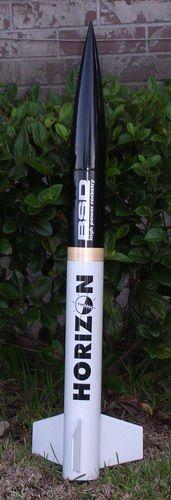BSD High Power Rocketry Horizon (3")
BSD High Power Rocketry - Horizon (3") {Kit}
Contributed by Mark Morris
| Construction Rating: | starstarstarstarstar_border |
| Flight Rating: | starstarstarstarstar |
| Overall Rating: | starstarstarstarstar_border |
| Manufacturer: | BSD High Power Rocketry  |
Brief:
The BSD 3" Horizon is a wonderful kit designed for the builder new to high
power rocketry. It flies on 29mm SU or RMS motors from G to low H power. This
was my first HPR rocket.

Construction:
The kit went together very easily with extremely clear, well written, and
detailed instructions, including many black and white photos of the build
process. Construction starts with assembly of the motor mount. The kit includes
a nylon recovery strap that is to be epoxied to the motor mount, then the
forward centering ring notched to fit over the recovery strap is epoxied to the
front of the motor mount. I deviated from this by drilling two 1/4" holes
in the forward centering ring spaced to fit a 1/4" stainless steel U-bolt.
I installed the U-bolt with nuts and washers on both sides of the centering
ring. Epoxy was then coated onto the nuts to hold them securely. The front
centering ring was then epoxied in place. Epoxy fillets were then added to both
sides of the centering ring. I then attached 15ft of 1/4" tubular Kevlar®
with pre-sewn loops on the ends using a quick link to the U-bolt assembly. This
completed the motor mount assembly since I was just fitting the rear centering
ring so internal fin fillets could be added. Before installation of the motor
mount, fin slots need to be cut. BSD provides guide lines for the fin slots,
but the builder must cut them. I found this to be easy with a sharp hobby knife
and actually enjoyable. The motor mount is then epoxied in place except the
rear centering ring is only fitted in place until after curing was complete.
The rear centering was then carefully removed. Before installing the fins, I
put sharp double airfoils on the leading edge using a disk sander. The fins
were tacked in place using 10 minute epoxy followed by adding thick fin fillets
inside using 30 minute epoxy mixed with milled fiber to provide a very strong
joint. The rear centering ring was then epoxied in place and fin fillets added
similarly to the internal ones. Although BSD provides motor retention using
blind nuts, I used an Aero Pack retainer and epoxied it in place using JB Weld
as directed by Aero Pack. A loop in the Kevlar®
recovery strap 18" from the nose cone end was created using CA to tack it.
Kevlar®
string was then wrapped around this joint and all coated with epoxy to provide
a parachute anchor point. Construction was then complete. Quick links are used
to attach the parachute and the Kevlar®
recovery strap to the nose cone.
Finishing:
Elmers Fill 'n' Finish was used to even out the fin fillets and sanded to
smoothness with 400 grit sandpaper. Two coats of gray Krylon primer with
sanding in between followed by wiping down with a tack cloth were applied. It
was then painted with three coats of Rustoleum Gloss White. The rocket was then
masked off so that the front 6" was left unmasked. Three coats of
Rustoleum Gloss Black were applied to this front section and the nose cone.
After drying for two days, the vinyl decals were added. These are of superb
quality. Finally, it was sprayed with two thin coats Rustoleum Crystal Clear.
Construction Rating: 4 out of 5
Flight:
My first flight ever was with a G64-7W. I had help assembling the motor, but
the flight went off without a hitch. It was quite a thrill to see my first
flight work so beautifully. It was the perfect delay too. While this rocket has
now flown many times on G64s, this rocket really loves a H128-M or H165R. It
really moves out!
Recovery:
As previously mentioned, I changed the recovery strap to 1/4" tubular
Kevlar®.
I felt the nylon BSD provides would eventually burn through, but there's no
chance of that happening with the Kevlar®.
I feel the U-bolt I installed provides a more secure mounting for the recovery
system. On the first few flights, I thought the included 24" chute
provided too fast a descent, so I have now changed to 28" SkyAngle which I
reef slightly. The drift is a bit further, however, I like the descent rate
much better. The 24" chute would work for windier days, but for days when
the wind is less than 10 mph, it's too small.
Flight Rating: 5 out of 5
Summary:
This is a really great kit. It flies beautifully on rather inexpensive reloads
and scoots on low H power. Although I made some modifications, these were
purely my preference; it would still be a great flier built stock. This is an
ideal first HPR kit.
Overall Rating: 4 out of 5
Other Reviews
- BSD High Power Rocketry Horizon (3") By Peter Valenteen
Brief: The 3" Horizon is an easy to build sturdy mid-power kit geared towards mid-power beginners. It flies on a single 29mm motor, RMS or SU. Modifications: Recovery system as detailed below. Construction: -3" diameter tube 26" in length -12" plastic nosecone with 2" shoulder -three 1/8" thick plywood fins that go to the motor mount -two ...
 |
 |
Flights
Sponsored Ads
 |
 |











